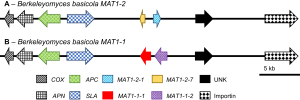Doutorando: Fernando Montezano Fernandes. (09/10/2018, às 16:00 horas no Anfiteatro do ESB). Orientador: Acelino Couto Alfenas. Resumo: About 20% of species in the fungi kingdom are known only by asexual fase, despite the various advantages of sexual reproduction. However, in recent years, sexual cycle has been induced in several asexual species. Fungi species without a known sexual cycle were termed imperfect or mitosporic fungi and were grouped into “Imperfect Fungi” or “Deuteromycetes”, although phylogenetic analyzes have shown that these are artificial groupings not based on taxonomic relationships. There is a strong evidence to support this claim, such as the recent number of asexual sequencing datasets indicating that they harbor a locus similar to mating and therefore have potential for a life cycle sexual. Mating in fungi is highly regulated and, in general, is possible only between cells of the opposite mating type. Types of mating are genetically defined groups of incompatibility that regulate whether mating is possible between individuals. Mating in the Ascomycota phylum represents a bipolar system under the control of a single mating locus (MAT-1) with two allelic or idiomorphic forms (MAT1-1 and MAT1-2). In addition, a large number of novel MAT1-1-1 target genes, which have never been related to any MAT-1 locus before, were attributed to functional categories beyond mating, such as asexual development, aggressiveness, morphogenesis, amino acid metabolism, secondary metabolism, and metabolism of iron. Reproduction has many advantages, such as the generation of genotypic diversity and the removal of deleterious mutations. Through the sexual cycle, new genotypes can be formed by recombination, and migration may lead to an introduction in areas where they did not occur before. Thus, the discovery of sexual cycle in fungi and its implications represent an advance for the management of plant diseases.

